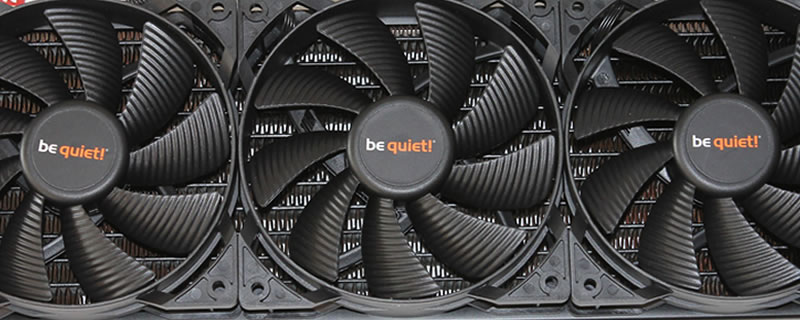beQuiet Silent Loop 360mm AIO Watercooling Review
Â
Conclusion
While 360mm based AIOs aren’t exactly common place yet, we are starting to see a few more 360mm rad based AIOs enter the very competitive AIO market, which, it has to be said is totally dominated by the 240mm rad based units.  The reason for this is really quite simple, there are an increasing number of cases that will accept the 360mm units.  Having already cast our critical gaze over the be quiet Silent Loop 240 as part of last year’s mega test, we were extremely keen to see how the 360mm version would measure up.
So what do we have? Well as you’ve worked out by now, the be quiet Silent Loop 360 is a 360mm rad based AIO. The Rad itself is 30mm thick, so when combined with 25mm thick Silent Wings 2 fans it gives the whole assembly a thickness of 55m The Rad isn’t dressed up in fancy acrylic panels, neither are there any graphics on it, so if you’re looking for a bit of bling you’ll need to look elsewhere, neither does the system support software integration to control fan and pump speeds and the like, so again, if you’re after then then move along the bus. What you do get is a nice simple radiator, albeit one that could have done with a second pass of the spray paint gun, and a cold head pump assembly that is the picture of elegant simplicity. The pump and rad are separated by 390mm lengths of high gloss black tubing which are each entwined in gloss black anti kink coils. be quiet have thoughtfully made the tubing and fan cables a bit longer than they would be for a 240mm rad based system to allow for the additional distance a 360mm rad causes tubing and cables to have to travel.
The instructions that come with the Silent Loop 360 aren’t the most intuitive or easy to follow, which is an issue we’ve raised before with regards to be quiet. Fortunately we’ve had lots of practice here at OC3D towers, so it didn’t take us long to sus things out and get it up and running. As usual we allowed a 30 minute bed in period before commencing the gruelling torture tests.
So how did the Silent Loop 360 fayre? Well, not bad, but it has to be said not brilliantly either, especially for a 360mm rad AIO. OK, so we’ve got the rad in the front of the case, as opposed to the roof, and we haven’t got the front fans pulling cool air in. We’ve also had to rig the AIO in a “Pull†configuration, as the fittings that came with it weren’t quite long enough to secure the fans to the rad after passing through the case bulkhead, but do you know what, we turned the fans around so they were blowing from the inside of the case, left the case door off to give it some fresh air to work with, and it didn’t make a blind bit of difference. Overall, the Silent Loop 360 performed better with skylake than Kabylake, but neither performance was up to scratch for a cooler of this size and this price. So why the poor performance? Well we suspect it’s a combination of a few factors, not least of which is the low radiator density. Most rads of this type have a fin count of around 19-20 fins per inch, and around 13 visible water channels. The Silent loop 360 has only 16 fins per inch and just 11 visible water channels. Meaning there is less surface area for the movement of air to act upon. The other issue is that we’ve never been very convinced that the cold plate mounting method gives a good strong bond to the CPU lid. And before you as, yes we’ve done everything correctly, and yes we’ve re seated and tried again. Sure there is the argument about it being built for silence, but it does still need to be able to perform to a reasonable at the same time and shouting “but its quiet” isn’t an excuse for “its not performing”. In reality at its best it performs the same as a 280mm Radiator with those fans actually running slower and quieter too.
All in all a bit disappointing for the be quiet Silent Loop 360. As the saying goes, it’s not actually bad, but my god should it have been better.
You can discuss your thoughts on the beQuiet Silent Loop 360 Review on the OC3D ForumsÂ



